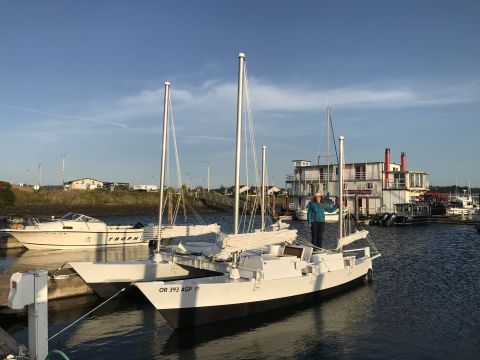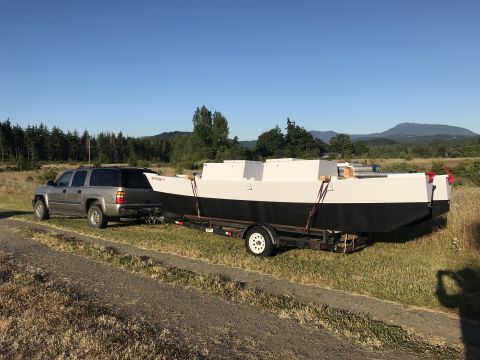
(Updated 9-25-2020)
--Second Sea Trials, September 2020
--Final Sea Trials, September, 2021

At the dock in Newport, Oregon
We're back from the initial sea trials with Minimus II and are quite pleased with her. The trials answered some of our more fundamental questions, most importantly, that she has ample freeboard even when fully loaded. This was a significant concern, given her heavier than typical construction for a multihull. Also that our intended use is for voyaging, so it's essential that she can carry 2 crew plus provisions for 4 to 6 weeks at sea. Fully loaded, she did in fact have the freeboard we were hoping for. She also moved along quickly, even with minimal wind--a striking contrast to our original Minimus, a moderately heavy displacement Cape Dory 25. Another marked contrast with the bermudan-rigged Cape Dory was the ease of handling the junk rig and the ability to do it from the security of a large, stable deck.
She got lots of positive comments from dock walkers, who seemed fascinated with her. Most of them were about how Polynesian she looked and questions about the rig.
Here in more detail is a report on the initial sea trials, both the ups and the downs.
We trailered her out to Newport, Oregon about 10 days ago. Newport is on the coast of Oregon and about a 45-minute drive from the farm near Philomath where we spend summers and where we built her last summer. In several respects, Newport is not ideal for sea trials, but is the closest place for us to do them. While we were there, winds often gusted to 20-25 knots, which was quite a bit more than we wanted for getting used to a boat and rig that were new to us. The bay is narrow and the navigable portion even narrower, so we couldn't hold a course for long. There are many dozens of crab pot buoys to navigate around, lest they catch on the rudders. The bay usually has a 1-3 knot tidal current, which made getting GPS based, over-the-ground speed data difficult. We'd also hoped to get out the jetties to the ocean for unrestricted sailing, but there was frequent fog while we were there and in fact we couldn't even see the end of the jetties until the last day. The bar at the end of the jetties was often closed to small craft due to rough conditions.
 Loaded up for the trip to the Oregon coast |
 Minimus II ready to roll |
 Putting her together requires me lifting one end of a hull, then the other end, while Pearl puts wood blocks under the keel to gradually raise up the hull. |
 When the hull is high enough, we put beams across the trailer bed and lower the hulls onto them. We then go back and forth a few times gradually moving each hull outward until they're at the right distance from each other and the beam chocks on the decks are lined up to take the cross beams. |
Launching a boat that's largely lashed together and has all the cordage necessary for 4 junk sails is not a quick task. We spent a day and a half getting her ready to launch and most of another day setting up the sails. In the future we feel that time could be cut in half, as there were a number of decisions and adjustments we won't have to make next time. Given that she's designed for voyaging, not day sailing though, we don't see that as a major downside.
 Lashing is a big part of the launching process. Here I'm tensioning the beam lashings by standing on the lashing line. |
 After the lashings are on tightly, we do frapping turns at 90 degrees to the lashings. This really makes the lashings bar tight. Once done there's no movement between beams and lashings. 4 hands, two to guide the rope and two more to keep it tight are essential. Also helpful are a screwdriver and needle nose pliers to help guide the line when doing the frapping turns. |
 Finished lashing and frapping turns. One done and fifteen to go... |
 Beams, deck boards, masts and rudders on, ready to launch. |
Once she was in the water, she became a joy to live on and sail. On our first outing, which was early in the morning before the wind got up, we were sailing downwind with both mains up. We could hardly feel any breeze and she was still moving through the water at about 2 knots. That's a huge change from the Cape Dory. The next time we were out the wind was around 15 knots, gusting to 18 or so, and we experimented with taking down all sails. Surprisingly, she was still going around 2-1/2 knots downwind under bare poles. The 4 masted rig makes her easy to balance and she's very light on the tiller. Another pleasure, inherent to junk rigs, was the lack of flapping sails.
 In the water at last. |
 Pearl enjoying her first sail on Minimus II |
 Minimus II self steering downwind in a light breeze. With the two mainsails angled downwind in a dihedral, she's directionally stable and self steers. |
As we hoped, she self steers downwind with both mainsails up and angled forward to form a dihedral. On other points of sail, we have another method of self steering in mind, which uses the windward mizzen sail as a large vertical-axis wind vane acting through lines and blocks to the tiller bar. We hoped to test it on our last day, but unfortunately the outboard wouldn't start and we didn't go out. If we have a chance to launch her again in September, testing that will be a top priority.
Coming about when tacking to windward takes finesse and we'll be working on the best strategy next time we go out. Getting accurate data on how she sailed upwind was almost impossible given the current in the bay, but she isn't designed for that, so our expectations aren't high for that point of sail.
There was one notable exception to our enjoyment of her underway, which was the little 2.5 hp Suzuki outboard. We normally sail engineless, but decided to bring it along due to the restricted marina, narrow channel and lots of boat traffic. It frequently died after running a few minutes. On the last day, which had by far the best weather forecast, it wouldn't start at all, which prompted us to suspend sea trials a little earlier than we would have otherwise.
Accommodation-wise, there's sitting head room in each of the 4 cabins. We used one hull as the galley, with Pearl in one cabin and me in the other. We can see each other, converse and pass food through the open center bulkhead. We slept in the other hull, head to head. The bunks are about 24" (61cm) wide and we found them comfortable.
 Enjoying a meal of fresh Dungeness crab. Yum! |
 One of the many things we tested was her load carrying ability. Here we have aboard the ground tackle, dinghy, battery, all the rigging, personal gear and close to 500 pounds of food and water. That's about what we'd need for a voyage and she's just 1" (2.5cm) over her designed waterline. |
A significant design issue for catamarans is ensuring that the underside of the deck between the hulls is high enough above the water to prevent pounding in rough weather. It's amazing how many catamarans are poorly designed in that regard. A few years ago when we were in French Polynesia on the original Minimus, we heard several reports from crews of catamarans that pounded dreadfully at sea. Minimus II, fully loaded and with both of us at the front of the deck platform, has 33" (84cm) of clearance to the water. With both of us on the rear of the platform, it's 31" (78cm). That should be ample to prevent pounding.
Speaking of pounding, a minor concern was that the flat bottoms of her hulls might pound going to windward in choppy seas. She got well tested and it didn't prove to be an issue.
An expected result of the sea trials is a two page list of tweaks and additions, most of which we knew we'd want if she proved worthy. Things like comfortable deck seating, deck awning, solar panels, AIS, etc. She did indeed prove herself and we're already busy checking off items on the list. Notably, I worked on the outboard and it now starts every time.
Hopefully we'll get out again in September and will report further.